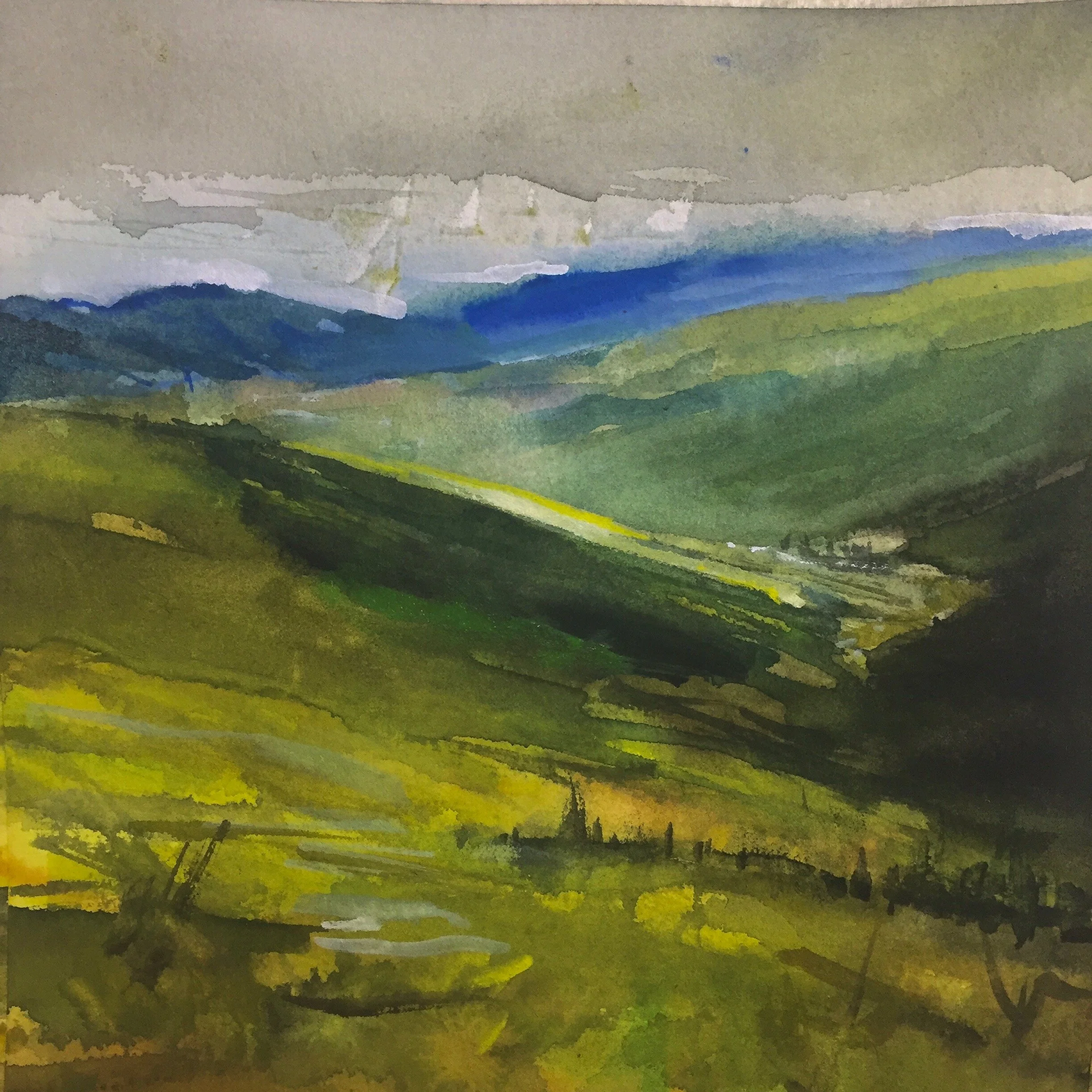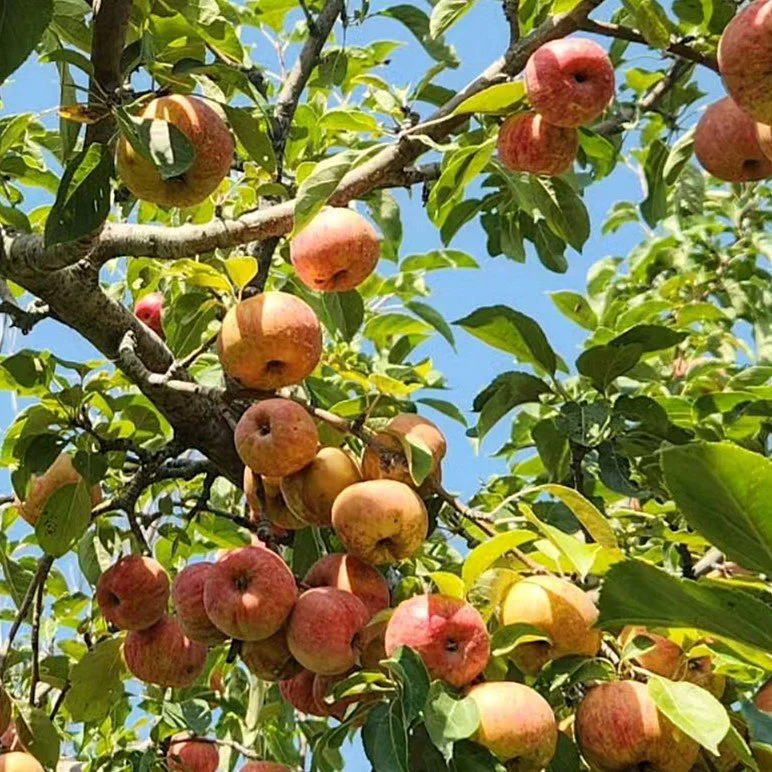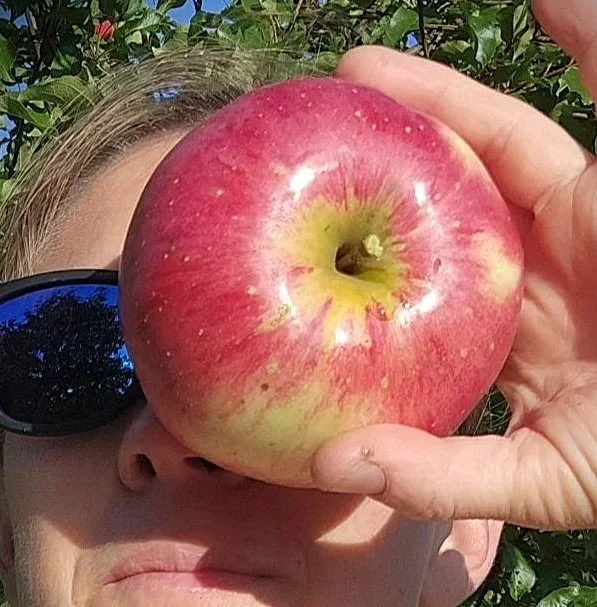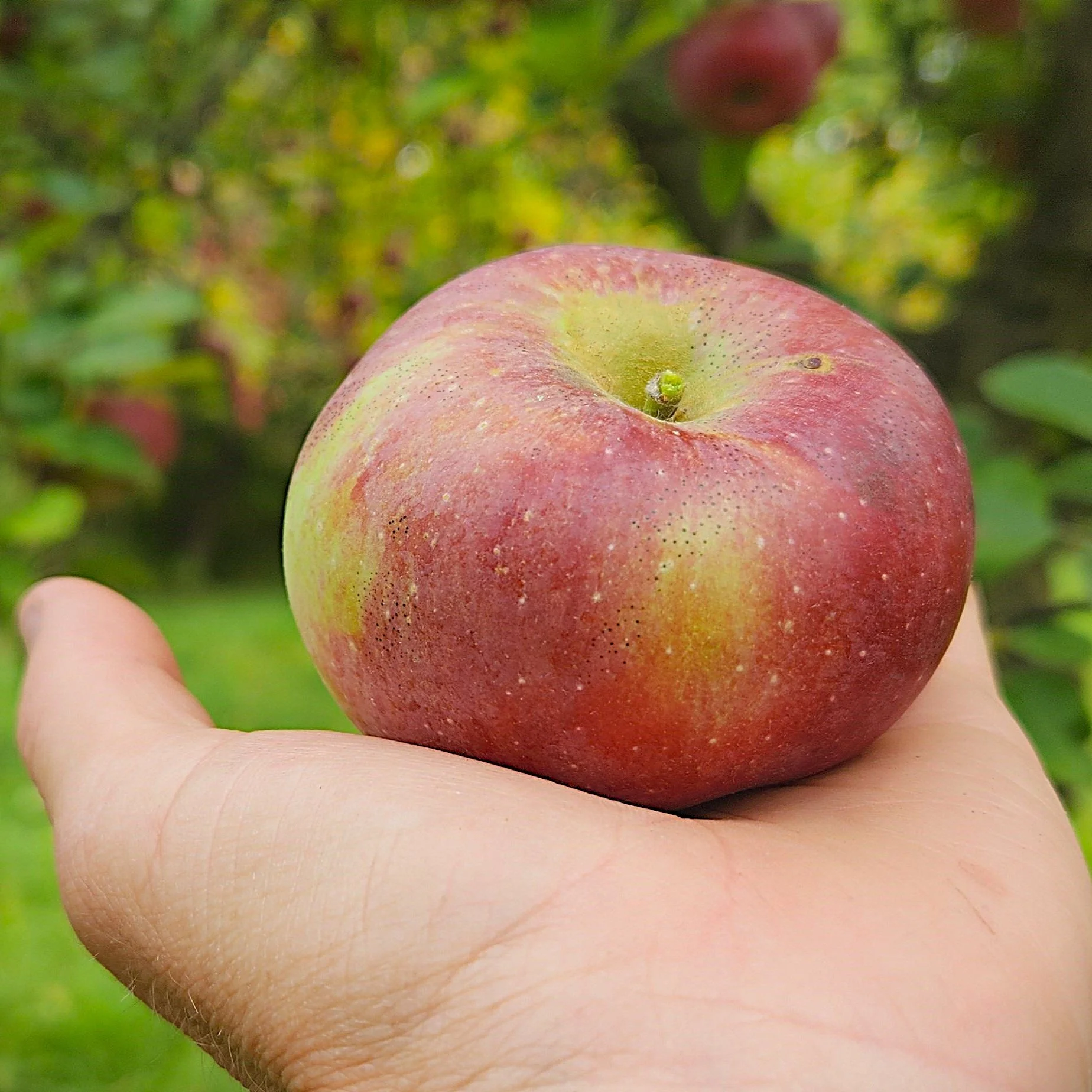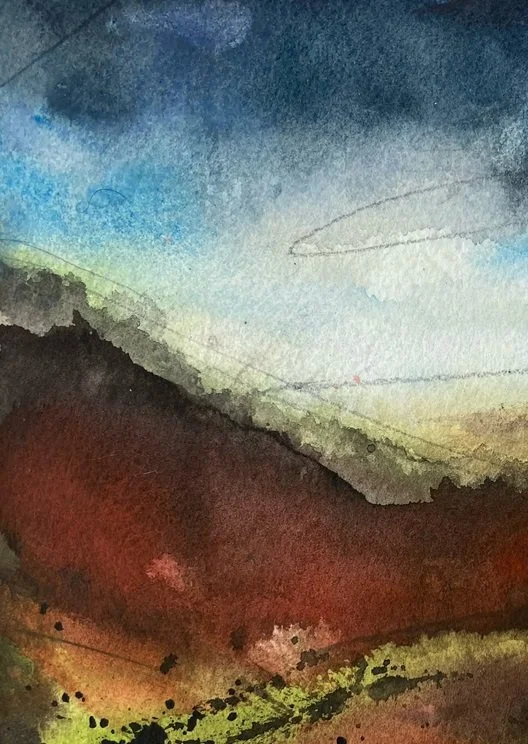
Open Spaces’ Apple Varieties
Varieties in (general) Harvest Order
-
![]()
Potomac Pear
From Cummins' Nursery, skin is glossy green and the flesh is fine, aromatic, and buttery. A subtle acid tang balances the sweetness. Potomac pears will store for up to ten weeks.
-
![]()
Pristine
From New Jersey, introduced in 1994. This lovely early apple has lemony-limey colored skin and creamy white flesh. Crisp and tart.
-
![]()
Bartlett Pear
According to Cummins' Nursery, this English pear is ...the most popular and common pear, and the yardstick by which all other pears are measured. Also known as Williams Pear, Williams' bon Chrétien. wide at the base with a narrow neck, with a finely speckled thin green skin that ripens fully to a clear yellow. The flesh is fine grained and very juicy, and the flavor is sweet and aromatic. The fruit is harvested around August 20th in upstate NY, and it should be harvested when still green (ideally pressure tested for ripeness) and allowed to finish ripening to yellow off the tree. Bartlett stores well, will hold its form when baked, and is an excellent fresh eating pear.
-
![]()
Crimson Crisp
From Cummins Nursery website: The fruit is an attractive crimson and orange flushed over a yellow background. The flesh is crisp, juicy, and sweet-tart, very similar to Honeycrisp. It is slow to brown when cut, and it makes a great salad apple.
-
![]()
Mac
From Cummins website (again!): Perhaps the most iconic apple of the modern era, McIntosh is a round, slightly flattened, mid-sized fruit. The skin shows a splash of cherry red over bright green and the flesh is bright, bright white. This apple is known mainly for its distinctive flavor: perfumed, subacid, spicy, and vinous (like wine). It has many progeny–Macoun, Spartan, Empire, and Cortland to name a few–and they all share the amazing Mac flavor.
-
![]()
St Edmund's Russet
Notes borrowed from dear friends at Out On A Limb (Maine):
An early ripening russet, the flesh is juicy and crisp and has a sweet, slightly tart flavor that is reminiscent of pear. (Or maybe it is the feel of the skin that makes of think of pear.) We recommend this russet for fresh eating.
-
![]()
Paula Red
Large lenticels (the white spots on the skin), red/green skin. Softer flesh like a McIntosh with a bright juicy tang. Easy to eat out of hand. Falls apart quickly when cooked - great for applesauce!
-
![]()
William's Pride
Yellow flesh, deep red skin, over a yellow cream base. Super early disease-resistant variety with crisp mid-season apple quality. So good. Enjoy this while discussing with friends!
-
![]()
Tydemans Early
From Cummins Nursery…
”A sweet, aromatic offspring of Worcester Pearmain, early ripening. Also known as Early Worcester, Tydeman's Red. This mid-sized apple is sweet and juicy, and the aromatics are often described as strawberry. The skin is a deep red and the flesh is crisp and white with a tinge of green. Tydeman's Early Worcester ripens in August here in Ithaca, and while it might not be the most obvious candidate for cider, our friends at Eve's Cidery have created one of our favorite single varietals out of this fruit. "
-
![]()
Burgundy
These are SOUR!. And usually enormous. Bred in Geneva (1974). And often actually burgundy in color! Sometimes the pigment from the skins streaks into the flesh. Eat them fresh or use in juice, sweet cider and for drying. Pair with thin slices of extra sharp cheddar cheese for an umami-tart-sweet stunner blend of a snack -- Hope, one of our members, recommended this! So darn good! Also few in number, with only one seriously producing tree.
-
![]()
Honeycrisp
That yearned after sweet treat! Streaky pink over light green and yellow skin, this terrific eating apple gives a crunch like no other. Large crystalline-like cells shatter into juice. So juicy you may have to slurp. Eat fresh or store the prettiest, greenest looking ones (in a plastic bag!) in your fridge for a treat in December. These are fairly limited in 2023- we experienced a lot of damage and loss on this variety in the May freeze. The remainder still have some freeze damage, but we are excited to share what we can!
-
![]()
Mollie's Delicious
From NJ in 1948, Mollie's parentage includes Golden Delicious and Gravenstein. An early, larger apple with pink streaking and banana notes in the first bite. (Source: Orange Pippin and tasting!)
-
![]()
Akane
So delicate and amazing. Cheerful bright smallish red fruit with a thin skin and crisp white flesh. Bred in Japan and introduced to the US in 1970. A satisfying blend of tart and sweet with a smooth crunch makes these fantastic eating apples. Recommended for drying and also for pies as they hold their shape.
-
![]()
Red Free
Bred for superior disease resistance and is a high quality early apple. We find these to be mild, juicy, sweet, and floral. Flesh is white. Great for fresh eating and all-purpose cooking/drying/juicing.
-
![]()
Sansa
NO CROP IN 2024
Introduced in 1986 from a New Zealand-Japan effort. A cross of Akane and Gala. Sweet and flavorful, for fresh eating, pies, and cider.
-
![]()
Chestnut Crab
These pop with flavor. Complex sweetness with a slightly starchy flesh (which is where I find the chestnut reference). I think the ones with some russeting (yes, like a russet potato!) are the most flavorful.
-
![]()
Gala
-
![]()
Wolf River
Known to my friends with children variably as “The Nanny Apple- entertains a baby for an hour” and “Feed 9 children with one apple”, I did steal some official wording from Trees of Antiquity’s website. So more officially, Wolf River apple tree originated in Wolf River, WI in 1875. The Wolf River apples are enormous fruits, often 1 lb. or more, famous for one pie from one fruit. Wolf River apples have pale yellow skin almost covered with pale dull red. Soft, tender, creamy white flesh. Mostly used for baking and pies, but in the right climate on sandy soil it becomes a good dessert apple. I’ll say… it feeds 9 kids at a table. Take a few to try, and understand these are not graded, are in utility grade shape and are not counted in your share, so feel no pressure either way!
-
![]()
Sweet Sixteen
Melissa's new notes... I LOVE this apple. It gives a smokey, cinnamon-y golden feeling upon first bite.
Continued notes...
Its flavor is sweet and complex. Hints of anise emerge, as well as a nuttiness, spiciness, and/or essences of vanilla and cherry. The thickness of the skin so matches the consistency of the flesh that once bitten, there is little distinction. The crunch yields plenty of juice, yet gives enough substance to have a good short chew. It's a softer crystalline cell structure than Honeycrisp. Easy to eat out of hand and also highly rated for cooking. Butter-colored flesh. Keeps well in cold storage.
-
![]()
Bosc Pear
A European (possibly Belgian) variety, with the classic hourglass pear shape. Thick golden skin, buttery (buerré) flavor. Softens and ripens on the counter.
-
![]()
Liberty
This hearty mainstay of our orchard is bright, tangy, and useful for everything: fresh eating, sauces, baking, cider, you go for it. The delicate thin skin is a bright maroon with a purple/blue bloom over a yellow base. Slightly chewy flesh gives way to tart juice with an astringent/starchy finish that leaves the eater ready for the next bite. Apparently Liberties can do that for hard cider as well, and are one of the "dessert apples" (eating apples) that can contribute to a fermented blend. Popular for its resistance to scab and other diseases, its regularly abundant crops, AND its ability to do all of that and taste darn good.
-
![]()
Adam's Permain
A wonderful, deep description from my friends in Maine at Out On A Limb Apples: For the dessert-apple aficionado, Adam’s Pearmain fills the bill. It has a firm texture and a brisk, aromatic flavor: tart, citrusy, a little grassy, with a lemon head in nose. The medium-sized red-striped fruit has an unusual oval shape.
-
![]()
Macoun
From Cummins Nursery in Ithaca, NY…
This heirloom apple is the same shape and size as McIntosh, but with a more striped and deeper red coloring; the skin is a dark purplish red blushed over a green background. The flesh is greenish white and crisp yet melting. This is an aromatic, high-quality eating apple. Sweet-tart with a hints of spice and flowers, Macoun is a cult favorite in the Northeast, but the fruit drops readily, bruises easily, and stores poorly.
-
![]()
Fortune
From Cummins Nursery (Ithaca, NY)…
The fruit is large and attractive, a deep burgundy flushed over green. The fresh eating quality is high, with a sweet-tart, sprightly flavor that lingers with tropical and citrus notes. It stores well–for up to five months–and is a great pie and sauce apple. NYSAES notes that it has the processing qualities of a Spy.
-
![]()
Empire
Some bulk orders available
2024 Pick Notes from Michael: The eating experience is a winter sunrise over an alpine like with a dusting of snow.
Previous notes: In 1941, frost destroyed the apple crop at the Geneva (NY) Experiment Station. That fall, apple breeder Roger Way traveled to the Hudson Valley, gathered apples from a McIntosh and Red Delicious orchard, and planted the seeds out. He waited for the trees to bear, tasted everything, and selected this one. Empire apples have a similar feel to a Mac, but they store much better and have a bit more kick in the acidity department. Most people think they are better than either of their parents. Excellent for fresh eating, salads, sauce, baking, pies, and freezing. White flesh, plump, round, medium size fruit.
-
![]()
Jonagold
A cross developed in Geneva, NY, between the sugary Golden Delicious and the more acidic Jonathan. The result is a wonderful balanced sweetness - honey and a hint of tartness. A beautiful larger gold and green streaked reddish crisp and juicy apple. Great for eating, baking, and saucing.AND, Jonagolds make great fried apples. Simply saute in coconut oil and add a little cinnamon. They are also a key ingredient of sweet cider blends. Not a great keeper.
-
![]()
Tompkin's King
Holy school apple! These plump, deep red, bespeckled apples hearken back to when the the genre of eating apples encompassed an ENTIRELY different mouth experience than we are used to today. Yes, these are crisp- but not from a cell structure swollen with juice, more so it feels like from the sheer number cells packed so closely together. These apples startling dense. And the flavor is lovely. I recommend slicing them rather than biting into them. Also beloved for baking and sauce making.
-
![]()
Melrose
*some bulk orders available
The official state apple of Ohio. Large and slightly squat in shape, Melrose apples are a dusky red over a yellow-green background. Firm and pleasingly coarse in texture, this apple's luscious white flesh is juicy with a sweet and mildly tart flavor that becomes more floral and aromatic with age. Great for fresh eating and also for cooking. Actually, this variety makes fantastic sauce all on its own! Melrose is a great keeper.
-
![]()
Enterprise
A celebration of thick skin! Bred for disease resistance, these apples are impenetrable little maroon tanks, making them more self-sufficient in the orchard AND really excellent for storage. Tart with a hint of spiced sweetness, these flavors gradually release as you chew. If you're not a big fan of contemplative chewing, try slicing them up instead or throw them into whatever baked apple deliciousness you're into lately. (If they are too tart for you now, bag 'em up in your fridge and taste them again in a month. You can do this with any apple too tart for your liking right now.)
-
![]()
Macfree
Grown at Hemlock Grove, I (Melissa) don’t know much about this apple and it is an experiment in the Share!
St Lawrence Nursery in Northern NY says… All the good qualities of McIntosh, with disease resistance to boot! Bred in Canada, released 1974.
-
![]()
Hudson's Golden Gem
This gem was discovered near an Oregon nursery in 1931. Nobody knows who its parents were. It is a russet apple, with a rougher netting of dark skin. It also is a bit pear-like, but if you notice, it's like an upside down pear because the narrower end is away from the stem. Another name for this apple shape is "sheepnose." These apples never bear heavily, placing them in the "non-commercial" class. But fun to eat!
-
![]()
Spy
-
![]()
Golden Delicious
Discovered over 100 years ago in a West Virginia orchard. Great for fresh eating, baking and sauce. Also good to blend in sweet cider. We think these freshly-picked Goldens are better than most you can find in a supermarket, see if you agree!
-
![]()
Mutsu
From Orange Pippin…
Known as Mutsu in its native Japan and in the USA, Crispin looks like a large Golden Delicious and indeed one of its parents is Golden Delicious so it has that lovely sweet honeyed flavour.
-
![]()
Esopus Spitzenburg
Named in part for the Hudson Valley town, Esopus, where it was first discovered in the 1700's. Rough, blood red skin with gold flecks (lenticels). Slightly oblong, upright, and angular. Flesh is dense, crisp, and supremely flavorful. Said to be Thomas Jefferson's favorite apple, they are good keepers and were exported to England in Colonial times. Excellent eating out of hand, and also for juicing, making hard cider, and baking.
-
![]()
Keepsake
From Fedco Trees (Maine)…
One of the best of all winter storage varieties. Fine-textured flesh is hard, crisp, juicy and sweet. Excellent aromatic flavor, but wait about a month after picking before eating. Well named—keeps until July in the root cellar.
Irregular conic medium-sized fruit is almost entirely overlaid with stripes and a wash of very deep red. Same parentage as Sweet Sixteen. Resembles Frostbite and Sweet Sixteen in appearance and taste, although the flavor is not quite as intense. Fruit size can be somewhat small.
-
![]()
Baldwin
From Trees of Antiquity…
The Baldwin apple tree produces a bright red winter apple, very fine quality. The Baldwin apple tree was the most popular apple in New England. A harsh winter in 1934 wiped out most of the Baldwin apple orchards so its popularity was lost. Aside from cider making it was also known as an exceptionally good pie apple and due to its inherent hardness would maintain more crispness through the baking process than other apples would. The Baldwin apple makes a delicious cider base, and great for pies and eating fresh out of hand. The apple is often medium to large, sometimes very large. Skin yellow, flushed orange, striped red. Flesh firm to coarse, yellowish; flavor sweet and crisp.
-
![]()
Roxbury
-
![]()
Idared
*some bulk orders available
These highly productive, reliable apples have a mild sweet-tart flavor, are extremely juicy, and store really well. Large, flat fruits with dull, rose-pink skins and chewy, mac-like flesh. Excellent for baking and sauce - these apples hold their shape perfectly and make delicious soft and tender pies.
-
![]()
Golden Russet
Classic hard cider apple due to its very high sugar content (where the booze comes from) and its aromatics and acidity (where the nuanced flavors come from). Check out its old-fashioned, hard texture. Back before refrigeration, this beauty blanketed the shores of Lake Ontario, prized as it was for winter storage. Rough, chartreuse skin wrapped in gold with granular crisp flesh. Eat fresh or pop into a pie. This is a remarkable apple.
-
![]()
Spigold
From Cummins Nursery (owned by the younger brother of James, who planted these trees)…
This a large, firm apple. In The Illustrated History of Apples, Bussey notes that a bushel of Spigold will weigh about ten pounds more than an average bushel of apples (55 pounds to the average 44 pounds). A cross of Golden Delicious and Red Spy, this fruit is ribbed and flushed orange-red over gold. It has all the crisp, juicy sweetness you would expect from a Golden Delicious progeny, but the flavor also has the sprightly zest of a Spy. In a good season, when the fruit has received enough sunlight to develop full flavor, Spigold will be aromatic with notes of citrus and spiced honey. The apples will hold to the tree after ripening and store well for about two months. Well regarded as a baking apple, Spigold keeps its form in a pie.
Spigold was developed by Dr. John Einset and Leo Klein at the breeding station in Geneva, NY. The cross was selected in 1944 and introduced in 1962.
-
![]()
Fuji
This apple comes from a single tree in the Gunderman Rd orchard. It is the best version of ‘Fuji’ I’ve had!
Modern, Japanese apple. Lovely pink speckled flush over a yellow-green background. It is also crisp and juicy, with dull white flesh which snaps cleanly. The flavor is predominantly sweet, very refreshing (especially if slightly chilled), but perhaps not particularly outstanding.
-
![]()
Goldrush
Modern variety from Purdue. A highly flavored, late-season dessert apple, perfect for organic production. (Quote from Cummins Nursery)


